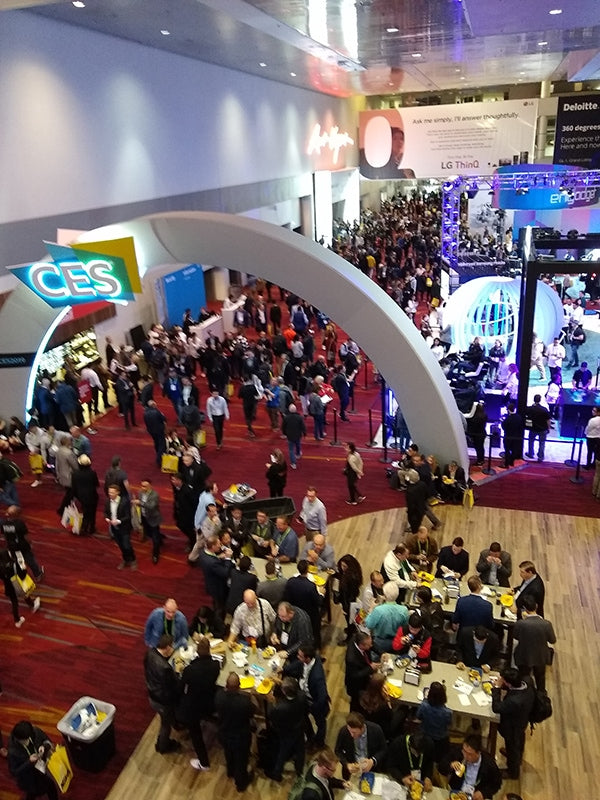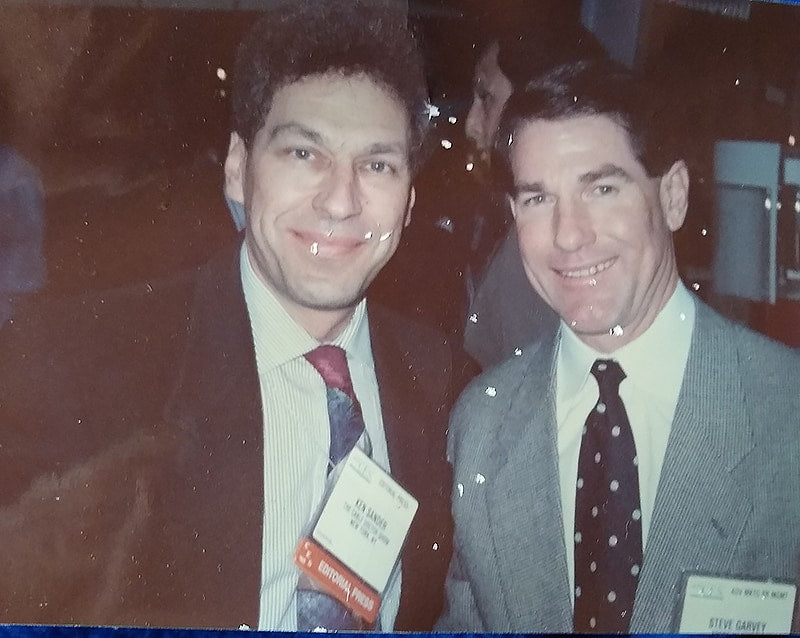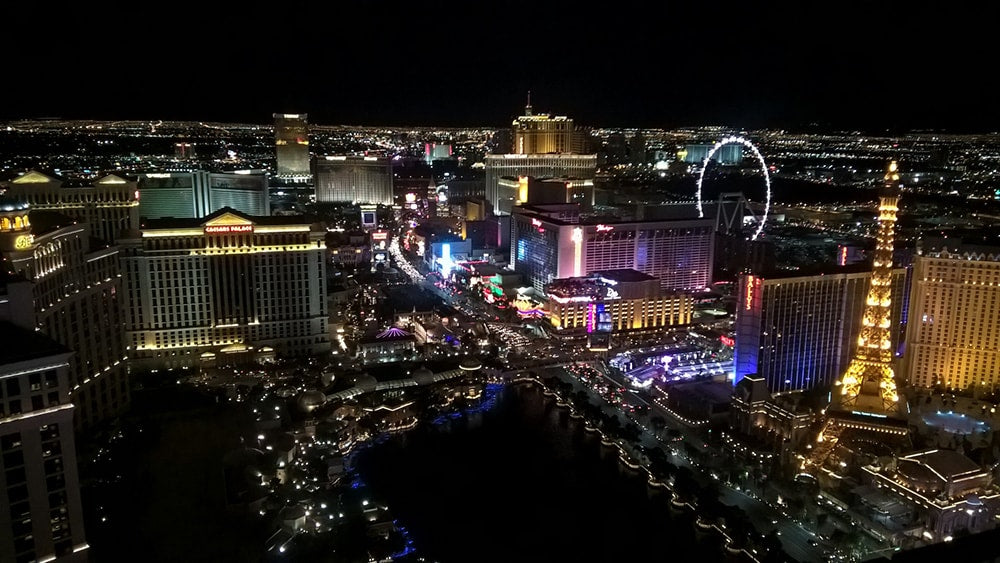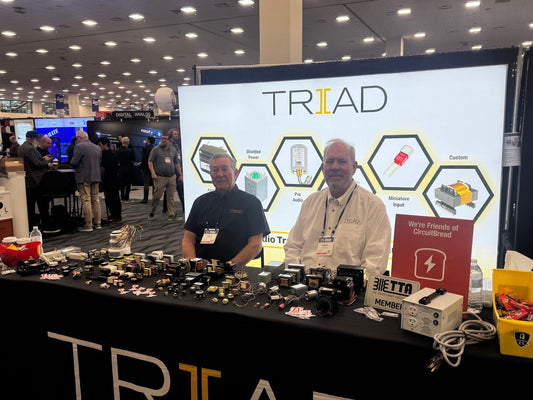In my early years of attending CES in the 1990s, I would take the redeye home from Las Vegas. That would prevent the loss of a full day flying back to New York, and eliminate having to pay for the price of the room for another night. Ah, but a free lunch has its price. This flight was always packed and truly uncomfortable. After one CES, about an hour into the flight, the guy next to me starts having a seizure. I pushed the help button for the flight attendant. She came within a minute, and he was still having spasms. With some help, we got him into the aisle and laid him down. I held his arms down to keep him from hurting himself. As his spasms subsided, I checked his pulse. It was a little high, just under 150 BPM, so it was not in the danger area. In a half a minute his seizure stopped, and he slowly regained consciousness. The flight attendant thanked me and asked what my medical training was. I told her I had been a medic in the Army.
After seeing that he had recovered, she moved the passengers from the first row and seated him and me there. We settled in and I asked him if he had ever had a seizure before, and he said no. Then he admitted that he was partying in Las Vegas, and he had not slept for three days. He was a big guy, in his late 20s, and seemingly healthy.
Five minutes later the flight attendant came back and asked me if I would come to the cockpit to talk to their doctor on the ground in Denver. Uh oh, I thought to myself, I certainly do not want an emergency landing in Denver. We walked through first class and into the cockpit. The pilot had the radio speaker on, and he introduced me to the doctor on the ground. The doctor asked me what the guy’s pulse was and his general state of being. A few more necessary questions were asked and answered, everyone in the cockpit thanked me and I went back to my seat. Interestingly enough, this fella had no memory of the seizure, and he was skeptical about it even happening. For his benefit, I asked other passengers and they confirmed it to him, but he was still asking, “are you sure?”
The rest of the flight was uneventful, and we landed in Newark. Everyone stood and got ready to deplane. Martha Whiteley from Panasonic saw me and yelled, “Of course, it’s the Cable Doctor, hey Ken you really are the doctor!” I also saw Rebecca Day (reporter for Consumer Electronics Daily and others) and a few other folks I knew on the plane. They all started teasing me in a good-natured way. The crew stood by the plane’s exit and thanked me again. At the baggage claim, the guy stood away from everyone else like he was embarrassed. Thinking back, don’t ya all think Continental (United) should have given me some kinda ticket voucher for my effort?
Back in the city, there were always press conferences and events that were newsworthy. One such event featured Bob Guccione and his wife, Kathy Keeton, his co-publisher of General Media. At that time General Media had approximately 15 magazines including Penthouse.
My colleague Brent Butterworth and I decided to attend. He served as the video camera and sound operator. The event was on 41st Street between Broadway and Sixth Avenue [Avenue of the Americas], in an interesting venue.
Easily over two hundred guests attended, including a healthy assortment of the press. There were no news announcements, but Bob and Kathy stood on the stage in a lighted area and posed for pictures. I found it interesting that they both had smiles on their faces and seemed to be looking at something but really nothing at all. They were able to hold those positions for what seemed like 15 minutes.
After that Brent ran into a friend who told him Glenn Kenny was there, and we started looking high and low for Kenny, a film critic and author who now writes for The New York Times and RogerEbert.com. We never found him, and as we were milling around, a public relations person approached us and asked if we would want to interview Bob and Kathy. Sure, why not? They took us up to a VIP room and introduced us. Brent set up while I chit-chatted with the both of them.
I started interviewing them with my questions split up between the two of them. Easy softball questions. I had heard that Kathy had cancer, but I did not think that would be a cool thing to talk about. Imagine my surprise when she brought it up. She looked great and there was not an inkling of her being sick. We talked about it, and she was very open. Kathy said she had breast cancer, but she would be fine. She seemed certain that she would beat it. Laughter was a valuable tool, she stressed. The interview went on for 20 minutes and their PR person motioned for me to wind it up. Both were very gracious and thanked me for the interview.
About four months later Bob and Kathy were on the Geraldo Rivera’s afternoon talk show and they were telling Geraldo that Kathy was cancer-free, they had found a cure. It was a very upbeat show, and they were emphatic that Kathy had beaten it. I was skeptical but I hoped it was so; I liked her. The next spring, I heard on the news that she had passed on.
My second CES was overwhelming. The astounding visuals, the sounds, and the entertainment. Now I was on my own. In those days there were exhibits in the North Hall and the Central Hall of the Las Vegas Convention Center. Just behind the North hall was the Westgate Hilton (now the Westgate Las Vegas Resort and Casino). They had three pavilions with smaller booths and tables. Many of these so-called booths were for small Chinese and Korean vendors. I would check these out on the last day of the show. I found that I could get tools for my shop; innovative fancy precision soldering irons and other tools at great prices. I should note that CES policy is that the show is exhibition-only, with no on-site sales allowed, but these small vendors did anyway. Enforcement on the last day was practically nonexistent and besides these small vendors were happy to get some cash and not have to take their stuff home. If you walked through the Convention Center going north, you got to the Westgate exhibits. They were further back in the hotel proper, with rooms that were used as manufacturers’ showrooms.

One of the hallways at the Las Vegas Convention Center during CES. The exhibit halls can get even more crowded.
Still being a newbie, I still did not understand the show’s layout well enough or had enough appointment requests to book my appointments in clusters close to each other. The walk from the middle of the center hall to the elevator banks in the Westgate was close to a mile. I made some newcomer geographic mistakes. Once I took a taxi to the Mandalay Bay and did not know where the JVC press breakfast was. I got out of the cab at the front of the hotel. The walk to the convention area was through the casino and past the pool. Overall, it was a mile walk.
Everything in Vegas was further away than it looked. One night Brent and I were walking between hotels off the strip. The hotel we were going to did not look far away but after 10 minutes we were no closer. The desert was like that.
An athletic running shoe company sent out pedometers to the attending press and I wore it at CES. I walked about 35 miles during the show. That turned out to be my average CES walking mileage. I was in my second year, and I was now getting press invitations to cocktail parties. I was making progress. I met and interviewed Steve Garvey, former second baseman for the Los Angeles Dodgers. He was very patient with me, and he gave me a good five minutes. I was still an unknown member of the consumer electronics (CE) press and not known to most manufacturers. So, I enjoyed these press parties. Mostly the food and drink were darn good and as a member of the press l hardly had to spend money on food while at the show.

Ken Sander and Steve Garvey.
At one evening event I saw these chocolate-covered strawberries. They looked delicious and were slightly bigger than a golf ball. I had not much experience with these delights, but I knew they existed and had to try ’em. Delicious, I ate three of those strawberries, I think. Then I noticed a member of the Canadian press. I said hello while taking bites out of a chocolate-covered strawberry. She took a step back and gave me a look. Odd, because most folks at the show are friendly. I turned away and decided to go to the men’s room. When I stopped at the sink to wash my hands I looked into the mirror and lo and behold, I had a big brown chocolate mark the size of an M&M on the tip of my nose. Not a good look.
In 1996 I opened the Cable Doctor shop at 226 East 14th Street in Manhattan. I signed a five-year lease. The initial rent was $1,300 a month for the first two and a half years and $1,750 for the next two and a half. At first, we did audio equipment and VCR repairs. That was in addition to service calls, which were always fruitful, (When I closed the shop in 2014 the rent was over $9,000 a month. Another benefit was that I could use the shop as a studio after hours for The Cable Doctor Show. By that time, I was shooting about 50 percent of the show on location, either at press events or at CES.
Out of the blue one afternoon, shortly after I established the shop on 14th Street, I got a call from Peter Bloch, the editor of Penthouse magazine. He tells me Bob Guccione watches The Cable Doctor Show and wants to hire me as a columnist to cover consumer technology. Peter quoted him as saying, “I like that guy, let’s hire him.” Peter asked if I could come up to Penthouse’s offices the next day to meet with him.
The next day I took the subway uptown just a couple of stops to midtown. I walk into Penthouse’s office building on 52nd Street and Lexington Avenue. In the waiting room, I saw covers for all the magazines that General Media published.
In just 10 minutes I was escorted to Peter’s office. He invites me in and asks me to be seated. Also in the room was Gerard Van der Leun, an associate editor. He tells me that Bob wants me to write a column called “Technomania” (Bob named the column). Peter introduces me to Gerard, and tells me I will be submitting all my articles to Gerard, and all dealings will be with him.
It is all good when I open my big mouth and say, “I hope I am a good-enough writer!” “Oh,” Peter says, looking a little taken aback. “Why don’t you write a sample article, and we can see what you can do?” Yikes, what a dumb thing to say. I am such an idiot! I go home and draft a story about this new company called Taser International. They make a legal projectile stun gun. It is legal because it uses CO2 as a propellant, and at the time all other stun guns used gunpowder, which is one of the reasons they are illegal. That evening I e-mail the Taser story to my older sister for her blessing, because she is a successful writer. After a few suggestions and edits from my sister Ellen, I e-mail it to Gerard. He likes it, and away we go!
Header image: Las Vegas at night. All images courtesy of Ken Sander.



